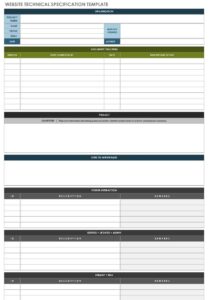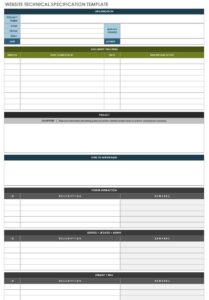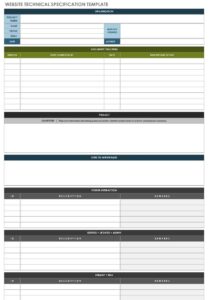Do you want to build a system that meets your needs? A system requirement specification template can help you with that. It is a document that defines the functional and non-functional requirements of a system. It serves as a foundation for communication between stakeholders, ensuring that everyone has a clear understanding of what the system should do.
In short, a system requirement specification template acts as a blueprint for your system, guiding its development and ensuring its alignment with your objectives. By providing a structured approach to defining system requirements, it helps prevent misunderstandings, reduces rework, and ultimately leads to a system that meets your expectations.
What is Included in a System Requirement Specification Template?
Typically, a system requirement specification template covers various aspects related to a system’s functionality, quality, and constraints. Let’s explore them in detail:
Functional Requirements: Define what the system should do, detailing its specific actions and outputs. They describe the system’s intended functionality from the user’s perspective.
Non-Functional Requirements: Specify how well the system should perform, encompassing aspects like reliability, usability, performance, and security. They define the system’s characteristics beyond its core functionality.
Constraints: Outline any limitations or restrictions that apply to the system, such as budget, timeline, or technological considerations. These constraints guide the system’s development and ensure feasibility.
Traceability and Prioritization: Establish a mechanism for tracking and managing requirements throughout the development process. It helps ensure that requirements are implemented and prioritized accordingly.
Glossary and Definitions: Provide a shared understanding of key terms and concepts used in the specification. This section eliminates ambiguities and ensures consistent interpretation.
Benefits of Using a System Requirement Specification Template
There are several advantages to using a system requirement specification template, including:
Improved Communication: A well-structured template facilitates clear communication among stakeholders, ensuring everyone is on the same page.
Reduced Misunderstandings: By providing a structured approach to defining requirements, it minimizes the potential for misinterpretations.
Enhanced Traceability: A template helps track requirements throughout the development lifecycle, ensuring they are implemented as intended.
Increased Efficiency: Using a template streamlines the requirement gathering and specification process, saving time and effort.
Improved Quality: A comprehensive specification template helps identify and address potential issues early on, leading to a higher quality system.
Conclusion
A system requirement specification template is an invaluable tool for ensuring the successful development and deployment of a system. By providing a clear and comprehensive definition of system requirements, it minimizes misunderstandings, improves communication, and enhances the overall quality of the system. Embracing a system requirement specification template is a wise investment in the long run, leading to a system that meets your specific needs and objectives.
Remember, a well-crafted system requirement specification template is the cornerstone of successful system development. By taking the time to define your requirements thoroughly, you lay the foundation for a system that meets your vision and delivers the desired outcomes.



